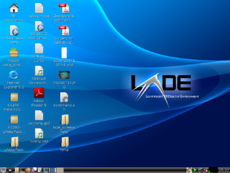LXDE
From 25C3 Public Wiki
| LXDE | ||

| ||
| Developer | The LXDE Team | |
| First released | 2006 | |
| Latest preview version | 0.3.2.1 | |
| Release date and age | 2008-04-20 | |
| Frequently updated | yes | |
| Programming language | C, GTK+ | |
| Platform | Cross-platform (Linux, BSD) | |
| Language | Multilingual (more than 35 different languages) | |
| Status | active | |
| Genre | Desktop environment | |
| License | GNU General Public License, LGPL | |
| Website | lxde.org | |
| Download | download.lxde.org | |
LXDE, Lightweight X11 Desktop Environment, is a desktop environment which is lightweight and fast. It is designed to be user friendly and slim, and keep the resource usage low. LXDE uses less RAM and less CPU while being a feature rich operating system. Because of the low usage of resources it also saves energy. We don't tightly integrate every component of LXDE. Instead, we try to make all components independent, so each of them can be used independently with few dependencies. This makes porting LXDE to different distributions and Unix systems easier. A good starting point is the General Information page, where you find information on system requirements and compatibility. You also find an overview of distributions including LXDE with installation instructions]], information on LXDE components and our future plans on the wiki. More about LXDE on the lxde.org website, the LXDE blogs, and in the LXDE forum.
Contents |
[edit] LXDE at the CCC
[edit] Where
- Wireless Corner
- BCC Underground
[edit] What
- Booth of LXDE Foundation e.V.
- Netbooks with LXDE
- Video Screen with LXDE Videos
[edit] Talks
- Mario will give a lightning talk on LXDE
- Day 2: Dec. 28, 2008
[edit] Who
LXDE Community Members at the 25c3
- Mario Behling
- André Rebentisch
- Cven
- Alx
- maces (Mo-2008-12-29)
- ....
- Please add yourself
[edit] LXDE Install Fest
Please bring old and extremely old computers. We will install distributions with LXDE and show you how fast old computers can be :-)
- Place: LXDE Booth First Floor
[edit] LXDE Components
- PCManFM, is a fast and lightweight file manager with features like Drag & Drop support, tabbed browsing (Similiar to Firefox), Built-in file searching utility, fast load of large directories, File association support (Default application), Thumbnail for image files, Bookmarks support, correct handling of non-UTF-8 encoded filenames and more
- LXLauncher, easy-mode application launcher
- LXPanel, desktop panel, The panel can generate menu for installed applications automatically from *.desktop files. It can be configured from GUI preference dialog, and there is no need to edit config files. The component provides a "Run" dialog with autocompletion.
- LXSession, session manager, The LXSession manager is used to automatically start a set of applications and set up a working desktop environment. Moreover, the session manager is able to remembers the applications in use when a user logs out and to restart them the next time the user logs in.
- LXAppearance, theme switcher. You can change the theme, icons, and fonts used by applications easily.
- Leafpad, text editor
- Xarchiver, archiving
- GPicView, image viewer, GPicView features lightening fast startup and intuitive interface.
- LXTerminal, terminal emulator
- LXTask, task manager / system monitor
- LXNM, lightweight network connection helper daemon for LXDE supporting wireless connections (Linux-only)
- Openbox, window manager
- LXRandr, screen manager, manages screen resolution and external monitors
[edit] How to join the LXDE team
- Subscribe our mailing list.
- Join our irc channel on irc://irc.oftc.net/lxde for online discussion.
- Help debugging/testing
- Writing wiki/docs
- Packaging for various distros, and make LXDE included in official repos of them.
- Write some programs for LXDE
[edit] LXDE Design Principles / Guidelines
- If only several simple APIs of another big library are needed, try to extract them and add them to your program instead of depending on the whole library whenever possible. (Beware of license)
- Only use libraries from other desktops when they are small or efficient enough and have few dependencies.
- Only create a daemon if there is a really good reason.
- Basic configuration options of applications should be editable via GUI whenever possible.
- Keep the user interface simple and intuitive. Never design some geek-style GUI.
- Consider the conventions of both GNOME and Windows, and try to follow the habit of most users. Do not deliberately make the GUI quite different only because you want to be different from Windows. Usability is always the top one concern. Windows might not be good in some areas, but like it or not, most computer users in the world get used to it. Trying to fight your users is apparently unwise.
- Try to shorten the startup time since this greatly affect user experience.
- Try to keep maximal compatibility with lower gtk+ versions (gtk+ 2.6 is preferred). Try to make features requiring higher gtk+ versions optional with proper conditional compilation and compatibility macros.Gtk+ version can be check in C program like this:
#if GTK_CHECK_VERSION( 2, 10, 0 )
/* write some gtk+ 2.10+ specific stuff here */
#endif
[edit] Development
Please check out the LXDE source code from our subversion repository at sourceforge
svn co https://lxde.svn.sourceforge.net/svnroot/lxde/trunk/ lxde

